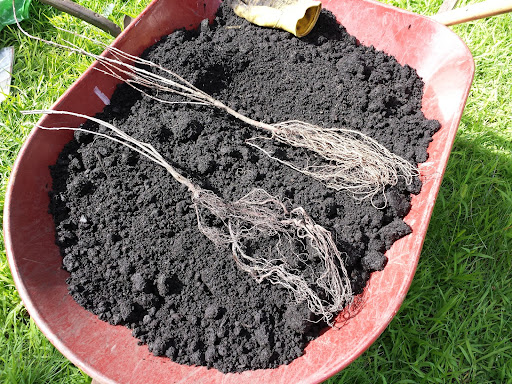This weekend, I was busy digging and planting new
garden beds. It may seem a bit late in the year to be digging and planting vegetables, but I’m mainly going after greens and things that produce in less than 60 days this year. With the first frost likely in September, I still have some time. This time I dug two beds. One in the front yard, and one in the back.
I prepared the first area by laying out some extra logs to get a rough idea of the size and shape. This one ended up being roughly 4x12 feet. The grass was problematic in the last bed I dug, so I used the weed trimmer to cut it down to the dirt. I raked the grass into a pile and used it as mulch on some other plants.

I spent what felt like two hours, but according to the dates on the photos was only 35 minutes digging the bed with a borrowed tiller. It doesn’t go as deep as double-digging, but is much faster. I also picked a 90F degree day to dig, so using the tiller was slightly less sweaty than digging by hand.

With a rake, I pulled out the remaining roots from the grass and made a small pile destined for the compost heap.

My soil isn’t the best as you can see from the photos, so I worked in some fertilizer to help the new seedlings get going. It is supposed to also have some helpful fungi and bacteria mixed in in addition to the usual fertilizer stuff. I’m a bit suspicious, but the reviews were quite positive. I guess we’ll see how it turns out. The fertilizer I used is:
Dr. Earth Organic 5 for vegetables. The directions on the back say to mix in about a cup per ten square feet, so I used five cups.

I also spread some finished compost on the top of the soil after racking it smooth. After pushing the logs back in place, it is ready to plant! I really like the look of the logs on the edge of this bed. It is nice way to recycle some wood. If these weren’t diseased with brown rot, I’d turn them into
mushroom logs and double the harvest from the space. Maybe I can get some to grow on straw mulch instead. Plants and fungi make a great partnership with each helping the other grow.

In the above bed, I planted some: spinach, mustard greens, northern lights chard, rainbow carrots, turnips, and some red amaranth. All have harvest dates at 60 days or less. I had a few leftover amaranth transplants, which found a home in the above bed.

The new bed in the backyard is much smaller. I’m nearly out of space back there. It is just a small 4x4 foot bed. I also outlined it with some left over logs from my neighbors tree. It was planted with collard greens, radishes, and some kale.

I watered both of them thoroughly, and now begin the waiting game. You can see some kale ready to harvest on the right edge of the above photo. Thinking about it making me hungry for another
green smoothie. Yum.
Now we wait for the tasty little plants to grow.





